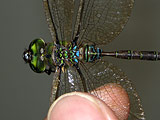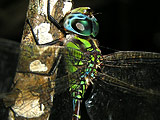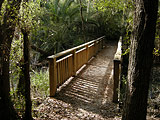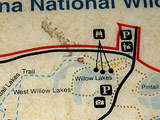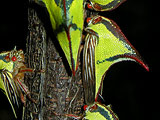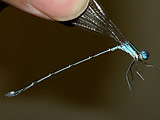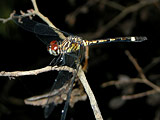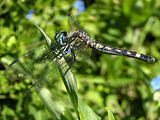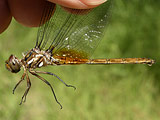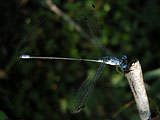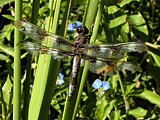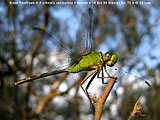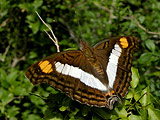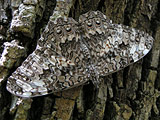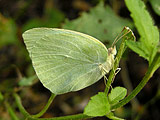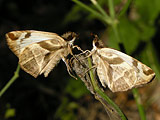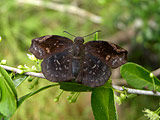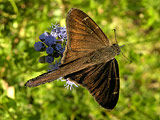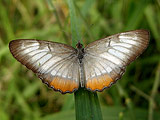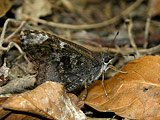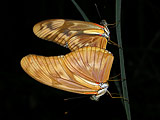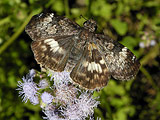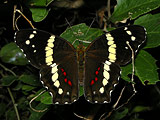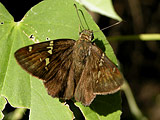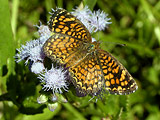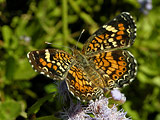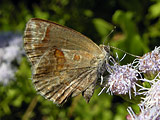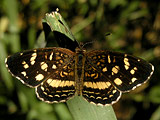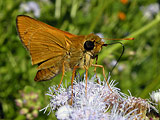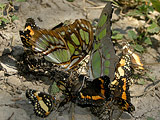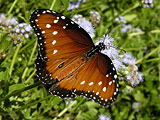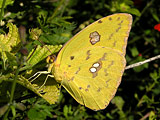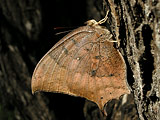
Texas 4: Lower Rio Grande Valley, October 16 - 20, 2008
In mid-September, Dennis Paulson and Martin Reid found Blue-striped Spreadwing Lestes tenuatus for the first time in Texas at the Santa Ana National Wildlife Refuge. They also found Caribbean Darner Triacanthagyna caribbea. This species was documented for the first time the U.S. at the refuge in November 2007 by Steve Collins. Having just returned from the Lower Rio Grande Valley, the news was a little aggravating for me to hear. From the photographs that Martin and others took, the darners were mature, so they were likely present during my visit but I did not see them. Thinking back I did glimpse a darner that seemed possibly different from all the Bar-sided Darners Gynacantha mexicana I was finding. It flushed up and disappeared over my head into the trees, a recollection that did little to settle my peace of mind.
I was not planning to revisit Texas. My last trip of the year was to be Southeastern Arizona at the beginning of October. But as the photographs of caribbea and other interesting species popped up in my e-mail, I grew more and more agitated. It was too late to get a reasonable airfare before October. I could go the weekend after returning from Arizona but I would have only two days at home before leaving again. Too tough being away from the kids. I settled on a short trip the following weekend. By then nearly a month would have passed and who knows if Caribbean Darner would still be around? Some of them looked a little worn in the pictures.
Thursday, October 16: The weather was bad when I arrived in McAllen, Texas shortly after noon. The forecast was for rain and the skies were gray. I drove straight to Santa Ana. After checking in and clearing my permit at the visitor's center, I took to the trails. Although the weather was not ideal for dragonflying, forest species are often crespuscular and hang up during the day. Under the overcast they might even be flying. I started down Chacalacha trail and immediately was greeted by a Malachite. A spectacular, large, green butterfly, I had heard this was a particularly good year for them. Closer to Willow Lake, a dragonfly was foraging low following along the trail. I plopped the net on it, a male Bar-sided Darner. It was mature, with brighter green and blue markings than the ones I saw back in September. His wings were tinted brown and he was draped with quite a few spider webs that he picked up in his travels through the forest.
There were lots of pondhawks Erythemis along the trails. Most were young Pin-tailed Pondhawks Erythemis plebeja along with some Great Pondhawks Erythemis vesiculosa. These were scarce in September. I saw a few more Bar-sided Darners, some flying and feeding, others hanging in the brush. Then something that looked smaller flew up and hung up in a tree. I got my binoculars on it and saw a green thorax with brown stripes - Caribbean Darner. In the hand, it was a young male, without any blue markings and the eyes still brown. I was happy they were still around and they were still emerging. Around 4 PM it started to sprinkle again so I headed to the motel to settle in.
Friday, October 17: Spent the day at Santa Ana. It was cool in the morning but the sky was brighter with the sun beginning to break through. I worked the Chacalacha trail checking areas that were good in September for Bar-sided Darners and where I found a Pale-green Darner Triacanthagyna septima. However there was very little I could find, likely because there was less water, the eastern end of Willow Lake having receded. I worked west along Willow Lake trail then headed down to Cat-tail Lakes. The Cat-tail Lakes trail was less forested and being more open I kept hoping for one of the rarer Anax species. During the previous weekend, (the weekend I couldn't come down) a few Amazon and Blue-spotted Comet Darners Anax amazili and concolor had been seen in the Valley. I saw a several Common Green Darners Anax junius and one Eastern Ringtail Erpetogomphus designatus but dragonflies were scarce. Much more common were the butterflies. There were so many in the forest and the open areas that their movements were distracting. Dave Hansen reported seeing 82 species in the Valley that day, the sun drawing them to nectar after a period of dreary weather. I ended up taking a lot of butterfly pictures without really trying.
I did find more Caribbean Darners. I found two more young males in the same thicket, but I wanted to find a mature one with brighter coloration. Further afield I found and caught a mature female, her eyes blue and her cerci broken off. I returned to the area where I found the young males and poking through the brush flushed up an immature female. She had likely emerged no more than a day or two before. Nearby I finally spotted my first mature male. He was hanging in the shade on some twigs just a couple feet off the ground. As I moved closer, he flew to another perch where several branches were in the way of my net. I gave it a try but came up empty.
Since the population appeared to be centered around this end of West Willow Lake I kept working the brush. It was getting later in the afternoon so I was curious if the darners would become more active. Then, flying along the edge of the lake was a small darner. The Common Green Darners that patrolled the lakes earlier were gone and a male Caribbean Darner was flying low over the water occasionally hovering to investigate the shoreline vegetation. Another small darner flew in and was chased. I made my way to the edge of the lake. The dragonfly flew by a couple of times, once down by my feet where I could see the blue between its wings but it was too close for the length of my net. It was getting dark and I felt like I was hunting shadowdragons Neurocordulia again. The darner didn't fly quite as erratically as some shadowdragons but the stop and start nature of its flight was difficult to anticipate and I had a hard time tracking it in the dying light. Finally I swung, missed, and it did not return.
Saturday, October 18: I met with Dave Hansen at Bentsen LRGV State Park in the morning. The previous weekend he and Jan and David Dauphin saw Amazon and Blue-spotted Comet Darners along the Resaca Vieja trail. We walked the trail and he showed me exactly where they found the dragonflies. I could imagine them perching in this tree or that tree. But imagining was all I could do since we did not see much more than a couple of Common Green Darners. A week is a long time.
We hitched a ride back to the visitors' center, and then took a quick look through the gardens for butterflies. While Dave headed to NABA butterfly park to look for an Evan's Skipper, I went back to Santa Ana determined to get a mature male Caribbean Darner.
Back at my "spot," on Willow Lakes trail, I found a couple more immatures before flushing out an adult male Caribbean Darner. I would find another nearby and even managed to take a few field pictures.
Sunday, October 19: I tried the Resaca Vieja trail at Bentsen again in the morning. Again I saw nothing of interest. What luck it was for these rare dragonflies to be found together here. I could not see why the habitat along this trail would be any more attractive than anywhere else in Bentsen or Santa Ana. Dry open forest, mesquite and grass. I found a small wet area but only a Band-winged Dragonlet Erythrodiplax umbrata was present.
Again I headed back to Santa Ana. Having collected what I needed for Caribbean Darner I was hoping for other possibilities like Pale-green Darner, Evening Skimmer Tholymis citrina (also seen at Santa Ana the previous weekend) and perhaps a rare pondhawk Erythemis species like Claret mithroides or Black attala. But first I stopped at Martin's spot along the Rio Grande 4 miles east of Santa Ana. It was my best place for dragonflies in April but I did not try to return after hearing that the construction of the misguided border wall had cut off access to it. But Martin reported visiting the site the week before so I wanted to try it. Being Sunday there was no one working on the levee. It wasn't clear to me that access was prohibited so I continued down the dirt road to the river. Still I didn't feel comfortable spending much time here but I did find one species that I was looking for, Straw-colored Sylph Macrothemis inacuta. I saw 3 or 4 males flying up and down the road and then the female that I needed.
I walked the trails of Santa Ana for the last time this year. I tried Pin-tail Lake and saw 3 male Twelve-spotted Skimmers Libellula pulchella a rare species in the Valley but they're having a good year. I walked the trail along the Rio Grande and had a Russet-tipped Clubtail Stylurus plagiatus. I saw this species emerging here in April. Except for a Variegated Meadowhawk Sympetrum corruptum, I didn't find anything else that was different. It will be interesting to see if the population of Caribbean Darner is able to persist. Santa Ana is not managed for dragonflies and areas are alternately flooded and then left to dry. I don't know if I'll be doing much work in Texas next year but someone will surely be looking and chances are, they will find something new. Seven species were added to the Texas State list in 2008. Of the seven, five were new to the United States, adding to my work load.
Monday, October 20: I took a quick look at Anzalduas County Park in the morning because Josh Rose had an Evening Skimmer near the dam on Saturday. There wasn't much good looking habitat there for this forest dweller but I tried. With time running out before my flight I ran over to Bentsen and walked Resaca Vieja one more time, out of a sense of obligation rather than having any real expectations. I was not rewarded. With a few minutes left I photographed a couple of butterflies nectaring at the flowers but their numbers were down. It had been sunny over the weekend and the butterflies had scattered.
Thanks to Dave Hanson, Josh Rose, and the staffs of Bentsen LRGV State Park and Santa Ana NWR. Thanks to David Riskind for granting permission to collect at Texas State Parks and Mitch Sternberg for permission to collect at Santa Ana/LRGV NWR.

